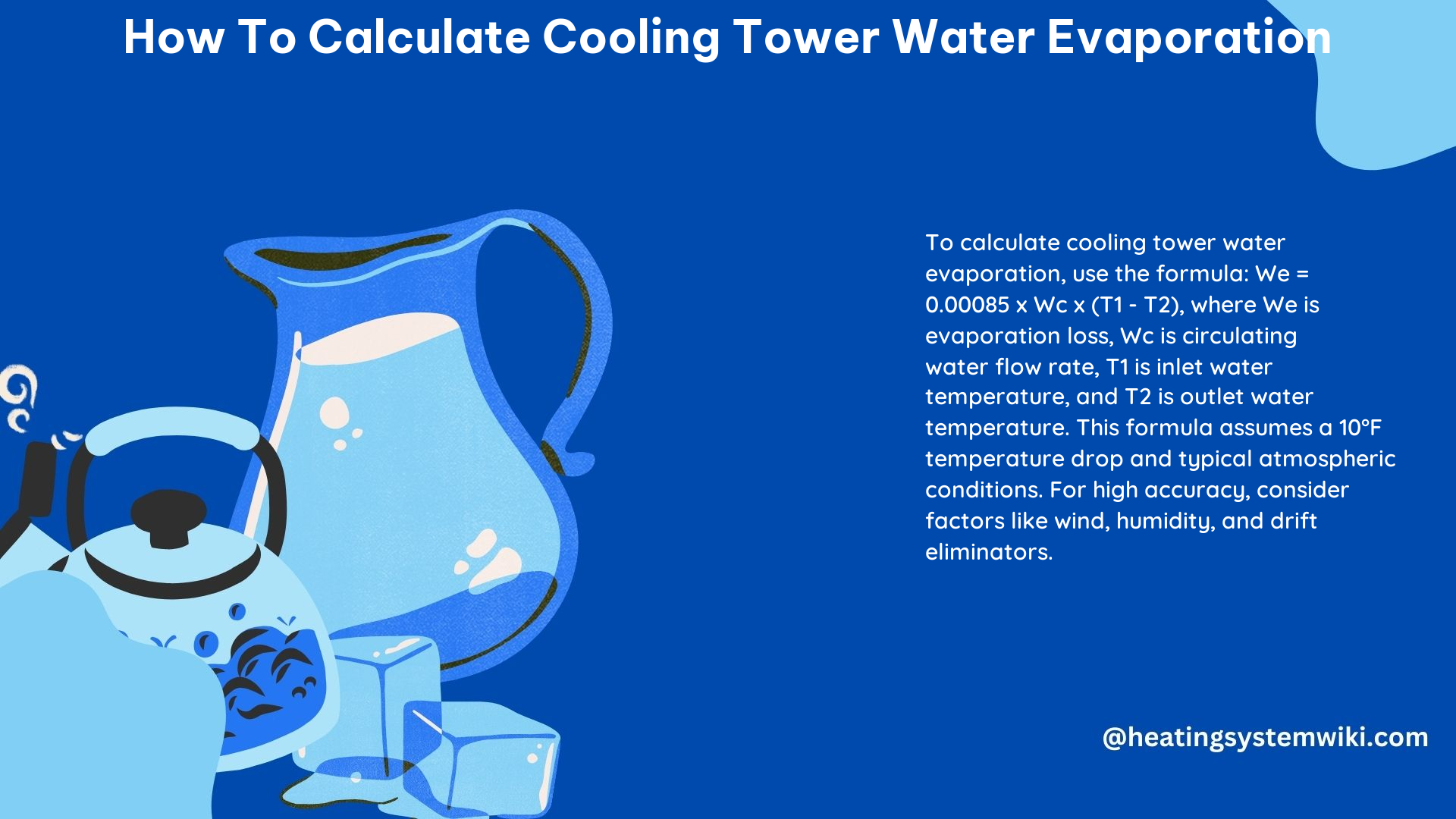Cooling towers are an essential component of many industrial and commercial HVAC systems, responsible for dissipating heat and maintaining optimal operating temperatures. Understanding the water evaporation process in cooling towers is crucial for efficient system management, water conservation, and cost optimization. In this comprehensive guide, we’ll delve into the step-by-step process of calculating cooling tower water evaporation, equipping you with the knowledge and tools to optimize your system’s performance.
Measuring Temperature Drop (ΔT)
The temperature drop across the cooling tower, denoted as ΔT, is the difference between the inlet and outlet water temperatures. This parameter is crucial in determining the amount of heat being dissipated and the corresponding water evaporation rate. To measure the temperature drop, you’ll need to install accurate temperature sensors at the tower’s inlet and outlet points, ensuring that the readings are taken at the same time and under stable operating conditions.
Calculating Recirculation Rate (R)

The recirculation rate, or R, represents the amount of water circulated through the cooling tower per unit of time. This value is typically measured in gallons per minute (gpm) or cubic meters per hour (m³/h). Accurate measurement of the recirculation rate is essential for calculating the evaporation loss, as it directly impacts the amount of water being evaporated.
Determining Concentration Ratio (CR)
The concentration ratio, or CR, is the ratio of the chloride content in the circulating water to the chloride content in the makeup water. This parameter is used to calculate the cycles of concentration, which is the number of times the dissolved solids in the recirculating water have been concentrated due to evaporation. The concentration ratio can be determined by analyzing water samples from the cooling tower’s circulating and makeup water streams.
Calculating Cycles of Concentration
The cycles of concentration, or COC, is the ratio of the dissolved solids concentration in the cooling tower’s circulating water to the dissolved solids concentration in the makeup water. This value is an important indicator of the tower’s efficiency and water management practices. The cycles of concentration can be calculated using the following formula:
COC = CR
Estimating Evaporation Loss (E)
The evaporation loss, or E, is the amount of water that is lost from the cooling tower due to the evaporative cooling process. This value can be calculated using the following formulas:
E = ΔT × R × 0.00085 (when temperature is measured in Fahrenheit)
E = ΔT × R × 0.00153 (when temperature is measured in Celsius)
Where:
– E = Evaporation loss (gpm or m³/h)
– ΔT = Temperature drop across the tower (°F or °C)
– R = Recirculation rate (gpm or m³/h)
Calculating Makeup Water (MU)
The makeup water, or MU, is the amount of water that must be added to the cooling tower to replace the water lost due to evaporation and blowdown. The makeup water can be calculated using the following formula:
MU = E × CR / (CR – 1)
Where:
– MU = Makeup water (gpm or m³/h)
– E = Evaporation loss (gpm or m³/h)
– CR = Concentration ratio
Determining Blowdown Rate (BD)
Blowdown is the process of removing a portion of the circulating water from the cooling tower to maintain the desired concentration of dissolved solids. The blowdown rate, or BD, can be calculated using the following formula:
BD = E × (CR – 1)
Where:
– BD = Blowdown rate (gpm or m³/h)
– E = Evaporation loss (gpm or m³/h)
– CR = Concentration ratio
Advanced Approach: Online Water Calculators
For a more advanced DIY approach, you can utilize online water calculators, such as the one provided by SPX Cooling Towers. These calculators allow you to input your specific operating conditions, including cold water temperature, wet-bulb temperature, and drift rate, and generate detailed curves and data to help you visualize and optimize your water usage.
The SPX Cooling Towers water calculator, for example, provides a user-friendly interface where you can input your tower’s performance parameters and receive comprehensive results, including water usage, energy consumption, and cost analysis. This tool can be particularly useful for complex or large-scale cooling tower systems, where a more detailed understanding of water dynamics is required.
By leveraging these online resources, you can take your cooling tower water evaporation calculations to the next level, ensuring optimal system performance, water conservation, and cost-effectiveness.
Conclusion
Calculating cooling tower water evaporation is a crucial step in managing and optimizing your HVAC system’s performance. By following the step-by-step guide outlined in this comprehensive manual, you can accurately determine the temperature drop, recirculation rate, concentration ratio, and cycles of concentration, and use these values to calculate the evaporation loss, makeup water, and blowdown rate.
For a more advanced approach, utilizing online water calculators can provide valuable insights and data visualization to further refine your cooling tower’s water management strategies. By mastering the art of cooling tower water evaporation calculations, you can ensure efficient operation, minimize water consumption, and optimize the overall performance of your HVAC system.
References
- Cooling Tower Makeup Water – CheCalc
https://checalc.com/solved/ctmakeup.html - Cooling Tower Basic Calculations – Yamatho Supply LLC
https://www.yamathosupply.com/blogs/news/cooling-tower-basic-calculations-2 - How Do You Calculate Water Loss in a Cooling Tower?
https://deltacooling.com/resources/faqs/how-do-you-calculate-water-loss-in-a-cooling-tower - Cooling Tower – Evaporation Loss Calculation – Eng-Tips
https://www.eng-tips.com/viewthread.cfm?qid=482041 - Water Calculator – SPX Cooling Towers
https://spxcooling.com/water-calculator/
